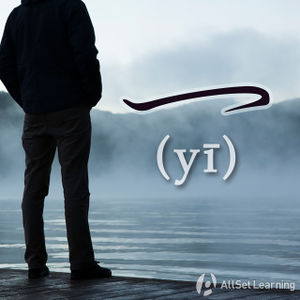Difference between revisions of "Events in quick succession with "yi... jiu...""
| Line 21: | Line 21: | ||
<div class="liju"> | <div class="liju"> | ||
| − | *老师 <em>一</em> 进来 大家 <em>就</em> 不 说话 了。<span class="trans">As soon as the teacher came in, everyone stopped talking.</span> | + | *老师 <em>一</em> 进来 大家 <em>就</em> 不 说话 了。<span class="pinyin">Lǎoshī <em>yī</em> jìnlái dàjiā <em>jiù</em> bù shuō huà le.</span><span class="trans">As soon as the teacher came in, everyone stopped talking.</span> |
| − | *他 <em>一</em> 下课 <em>就</em> 跑 出去 玩 了。<span class="trans">As soon the class is over, he went out to play.</span> | + | *他 <em>一</em> 下课 <em>就</em> 跑 出去 玩 了。<span class="pinyin">Tā <em>yī</em> xiàkè <em>jiù</em> pǎo chūqù le.</span><span class="trans">As soon the class is over, he went out to play.</span> |
| − | *老板 <em>一</em> 走 他 <em>就</em> 开始 抽烟 了。<span class="trans">As soon as the boss left, he started smoking.</span> | + | *老板 <em>一</em> 走 他 <em>就</em> 开始 抽烟 了。<span class="pinyin">Lǎobǎn <em>yī</em> zǒu tā<em>jiù</em> kāishǐ chōuyān le.</span><span class="trans">As soon as the boss left, he started smoking.</span> |
| − | *他 <em>一</em> 下班 <em>就</em> 回家 了。<span class="trans">As soon as he got off work, he went home.</span> | + | *他 <em>一</em> 下班 <em>就</em> 回家 了。<span class="pinyin">Tā <em>yī</em> xiàbān <em>jiù</em> huíjiā le.</span><span class="trans">As soon as he got off work, he went home.</span> |
| − | *你 能 不 能 不要 <em>一</em> 到 家 <em>就</em> 睡觉?<span class="trans">Could you please not go to sleep | + | *你 能 不 能 不要 <em>一</em> 到 家 <em>就</em> 睡觉?<span class="pinyin">Nǐ néngbu néng bùyào <em>yī</em> dào jiā <em>jiù</em> shuìjiào?</span><span class="trans">Could you please not go to sleep the moment you arrived at home?</span> |
</div> | </div> | ||
Revision as of 09:13, 24 November 2016
-
Level
-
Similar to
-
Used for
-
Keywords
This pattern tells us that as soon as (一, yī) one thing happened, then (就, jiù) another thing happened immediately afterwards.
Contents
Expressing as soon as with 一……就
Structure
The pattern involves two different events, the first preceded by "一", and then the second event, which follows in quick succession, preceded by 就.
Subj. 一 + Event 1,就 + Event 2
The subjects of the two "Events" can be the same, but they don't have to be. If they're the same, then you don't need to repeat the subject for the second one.
Examples
- 老师 一 进来 大家 就 不 说话 了。As soon as the teacher came in, everyone stopped talking.
- 他 一 下课 就 跑 出去 玩 了。As soon the class is over, he went out to play.
- 老板 一 走 他 就 开始 抽烟 了。As soon as the boss left, he started smoking.
- 他 一 下班 就 回家 了。As soon as he got off work, he went home.
- 你 能 不 能 不要 一 到 家 就 睡觉?Could you please not go to sleep the moment you arrived at home?
Expressing every time with 一……就
Structure
In this case, 一 means "every time", followed by some certain condition, which could be the reason or the cause of what happened after 就. The subjects of the two "Events" are usually the same.
Subj. 一 ……,就 ……
Examples
- 我 一 想到 这 件 事 就 不 高兴。Every time I think about this, I get upset.
- 她 一 看到 她 喜欢 的 那 个 男生 就 紧张 。Every time she sees that boy she likes, get nervous.
- 老师 一 生气 就 脸红。Every time the teacher gets angry, his face turns red.
- 她 一 吃 火锅 就 拉肚子。Every time she eats hotpot, she has diarrhea.
- 一 到 买单 的 时候 他 就 去 上 厕所。Every time we need to pay for the bill, he just go to the bathroom.
Sources and further reading
Books
- Common Chinese Patterns 330 (汉语常用格式330例) (pp. 184) →buy
- New Practical Chinese Reader 2 (新实用汉语课本2) (pp. 240) →buy
- New Practical Chinese Reader 3 (新实用汉语课本3) (pp.169) →buy
- Integrated Chinese: Level 1, Part 1 (3rd ed) (pp. 206-7) →buy
- Integrated Chinese: Level 1, Part 2 (3rd ed) (pp. 88-9) →buy
- Integrated Chinese: Level 2, Part 1 (pp. 85-7) →buy
- 40 Lessons for Basic Chinese Course (基础汉语40课上册) (pp. 173, 189)→buy



